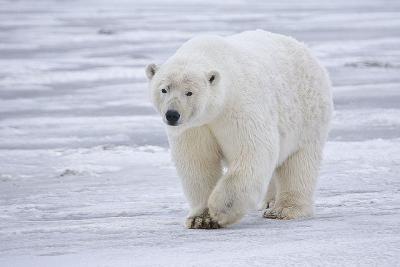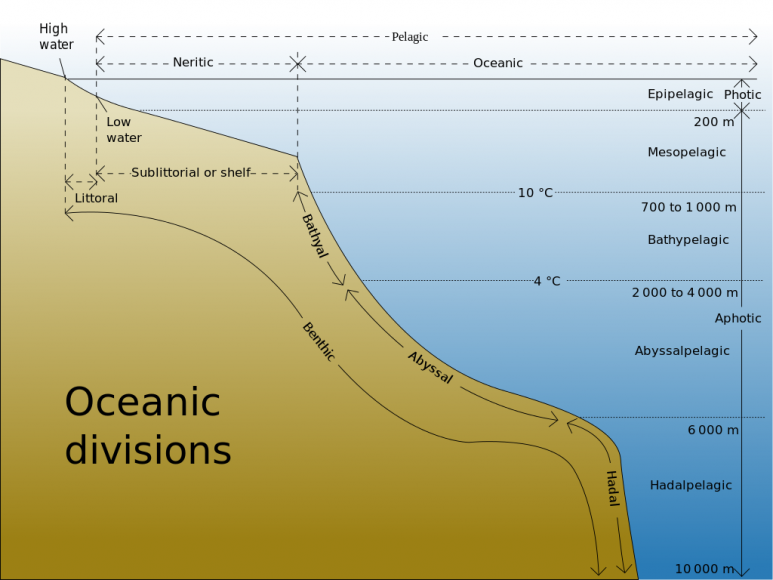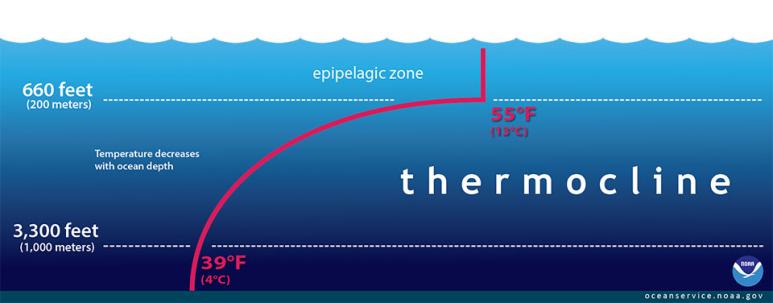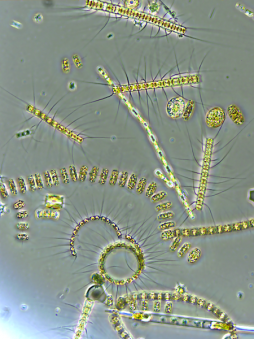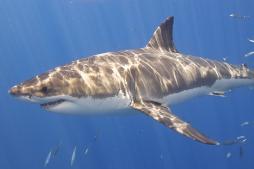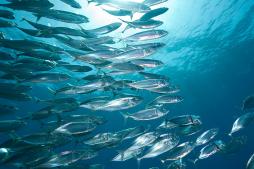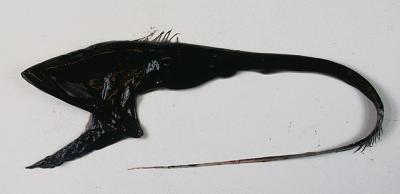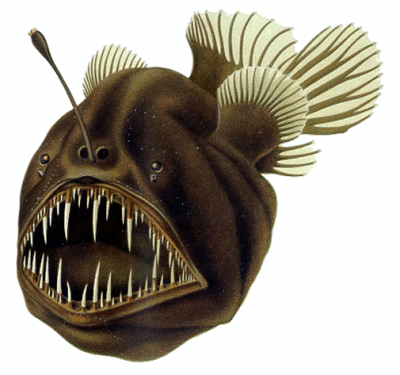Survival in the Open Ocean
Clarification Statement: Examples of evidence could include the needs and characteristics of the organisms and habitats involved. The organisms and their habitats make up a system in which the parts depend on each other.
Survival in a Habitat
Organisms often require specific abilities and adaptations to survive in a given environment or habitat. A polar bear, for example, wouldn't survive well in a desert, just as a camel wouldn't do well in polar regions (Fig. 1 & 2). Morphological traits, such as coloring that matches the surrounding habitat, provide the advantage of protection from predators. Other physiological or behavioral traits can also provide advantages for an organisms' survival.
Fig. 1. The white appearance of this polar bear helps it to camouflage in with the white snow.
Image courtesy of Wikimedia Commons
Fig. 2. The brown coloring of a camel helps it to blend in with the desert sand behind it.
Image courtesy of Wikimedia Commons
Natural selection provides a mechanism for species to adapt to changes in their environment. Organisms that are better suited for their environment will pass desired traits on to their offspring. On the other hand, individuals with traits that are less adaptive produce fewer (or no) offspring. In some cases, organisms may not be able to adapt to changes in the environment, and the species becomes extinct. Adaptive changes due to natural selection have strongly contributed to the biodiversity on Earth.
Habitats of the Open Ocean
The global, world ocean covers approximately 71% of the EarthвҖҷs surface and 90% of the oceansвҖҷ area is made up of oceanic zone habitat, with the other 10% being the coastal oceans. To understand the habitat of the open ocean (or the oceanic zone), we must first define what this area is and how scientists distinguish it from the coastal ocean. Each continent has a continental shelf that lies under the sea surface and slopes down to the oceanвҖҷs greater depths. The part of the ocean that overlaps this continental shelf is coastal ocean, also called the neritic zone, and is generally less than 200 m (650 ft) deep.
The open ocean habitat begins at the outer edge of the continental shelf, extending from the surface down to the deepest depths of the ocean floor. The water environment of this region, collectively referred to as the pelagic zone, is further subdivided by depth and the relative penetration of sunlight through the water (Fig. 3 and Table 1). The benthic zone refers to the ocean bottom, including all plants, animals, and structures (such as reefs) that live there.
Fig 3. Diagram of the divisions of the ocean.
Image courtesy of Wikimedia Commons
Table 1. The names, depths, and descriptions of the zones of the open ocean.
| Zone | Depth | Description |
|---|---|---|
| Sunlight | 0вҖ“200 m (0-650 ft) | This вҖңlightedвҖқ region is also referred to as the photic zone or epipelagic. Penetrating sunlight allows for relatively high photosynthetic activity of phytoplankton (generally, microscopic algae), providing energy and food sources for other organisms. |
| Twilight | 200вҖ“700 m (656-2,296 ft) | Also known as the disphotic zone or mesopelagic, some light penetrates here. Deeper water organisms here must rely primarily on energy sources generated from the photic zone above. |
| Midnight | 700-10,000 m (2,296-32,808 ft) |
Also referred to as the "aphotic" zone, the deepest layer of the world's oceans that gets no sunlight at all. These deeper and darker depths can be further subdivided into three regions:
|
Characteristics of the Open Ocean
The open ocean is vast and variable. In addition to light changes, pressure and temperature change dramatically from the surface to the deep sea. Warmer waters in the sunlight zone are mixed by wind and waves, creating a surface layer of relatively consistent temperatures. As depth increases, the pressure of the surrounding seawater also increases, but the temperature decreases. Below the upper, mixed layer of water, there is often a marked thermocline where the temperatures rapidly transition to the much colder waters of the deep ocean (Fig. 4). The properties of light, pressure, and temperature greatly influence the type of organisms that can survive in the different parts of the open ocean.
Fig 4. In this seawater profile, the red line shows the temperature change, or thermocline, as depth increases. This profile may look different between seasons and locations.
Image courtesy of NOAA
Creatures of the Open Ocean
Because the open ocean zone ranges from the sunlit warm waters at the surface, to the dark, cold, pressures of the deep, ocean organisms have adapted to survive in their specific environments. This section explores the variation of adaptations between the three light zones: the sunlight, the twilight, and the midnight zones.
The "Sunlight" Zone
Fig. 5. Sargassum is a free floating marine plant.
Image courtesy of Wikimedia
Fig. 6. Phytoplankton are an important food source.
Image courtesy of Wikimedia
The sunlight zone has enough light for photosynthesis to take place, and plant life thrives. Plants found in this region include free floating algae (often called seaweed), such as kelp or sargassum (Fig. 5), and microscopic photosynthetic organisms called phytoplankton (Fig. 6).
Plants provide food for animals, which in turn act as food for larger predators. In the warm sunlight surface waters, life is abundant. Many fish living there are fast, long-distance swimmers with efficient circulatory systems that provide the necessary energy to swim across large distances in the ocean to find scattered prey resources (e.g., tuna and sword fish). Other small, pelagic fish can fly out of the water to escape predators. The flying fish, for example, can actually double their escape velocity while airborne! Many whale species migrate thousands of kilometers each year, between their warm breeding grounds and their rich Arctic and Antarctic feeding grounds. Marine turtles make long voyages across the oceans, between their nesting beaches and feeding grounds.
Fig. 7. This great white shark has countershading.
Image courtesy of Elias Levy, via NOAA
To survive in the well-lit, exposed habitat of the open ocean, many types of animals have evolved a form of camouflage called countershading (e.g. sharks, rays, dolphins, and whales). These animals are darker on their top side and lighter on their under side (e.g. great white shark, Fig. 7). This makes them more difficult to spot from above (they blend in with the darker deep water below them), or from below (they blend in with the clearer shallow water above them).
Fig. 8. These Atlantic Mackerel school for protection.
Image courtesy of NOAA Fisheries
Many fish move in schools to survive in the sunlight zone. Schooling behaviors are thought to be protective to help fish avoid predation by confusing potential predators. Large numbers of fish, such as mackerel scad (вҖҳopelu) commonly found in HawaiвҖҳi, form a school and have abrupt, synchronous movements, which resemble a choreographed dance, and help them to survive (Fig. 8).
The "Twilight" Zone
The twilight zone is cold and dark, recieving very little sunlight from the waters above. Because there is not enough light for photosynthesis to take place, no plants live there. Animals living in the twilight zone have adapted to life in the dimly lit waters. Some species have enormous eyes to see in the darkness and large teeth to capture prey, like the viperfish (Fig. 9). To avoid being eaten, many animals are small and transparent or very dark (e.g. some jellies, squid, and crustaceans). Many aniamls use bioluminescence to make their own light to help find food, mates, and/or confuse predators (e.g., comb jellies, Fig. 10).
Fig. 9. Viperfish have massive teeth and eyes to survive in the twilight zone.
Image courtesy of Wikimedia
Fig. 10. This comb jelly is one of the many bioluminescent creatures found in the deep sea.
Image courtesy of Wikimedia
Because no photosynthesis takes place in this zone, many animals feed on the plant matter, or dead organisms, falling from the sunlight zone above. Some organisms undergo vertical migration, moving up from the depth at night to find food from the zone above and back down as the sun comes up (Fig. 11). The viperfish, for instance (Fig. 9), can also be found even deeper, moving between the midnight and twilight zones to feed.
Fig. 11. Daily marine life migration between twilight and sunlight zone.
Image courtesy of NASA, via Wikimedia
The "Midnight" Zone
The conditions of the environment in the midnight zone are harsh, with near freezing temperatures, extreme pressure, and complete darkness. Similar to the twilight zone, many organisms in this region have evolved to emit light through bioluminescent organs (like lanternfish and lightfish). Some also have very large eyes and/or stalked eyes (a protrusion that extends the eye away from the body, giving the eye a better field of view). Others have evolved the absence of eyes where complete darkness provides no selective advantage for sight.
Fig. 12. Gulper eels can expand their mouths to capture large prey.
Image courtesy of Wikimedia
Food is scarce at these depths and many organisms rely on marine snow for food. Predators need large mouths and teeth to capture whatever crosses their path. The mouths of gulper eels, also known as pelican eels, can expand to swallow preys at least as large as themselves (Fig. 12).
Check out this video recorded from the ocean explorer The Nautilus of a gulper eel balooning its massive jaws!
Fig. 13. Anglerfish have large teeth and a lure that hangs over their head in order to maximize prey capture in the deep ocean.
Image courtesy of Wikimedia
The fanged-tooth fish has the largest teeth of all marine animals in relation to its body size. Some fish have modified dorsal fins or other appendages that act as lures for attracting prey (e.g. anglerfishes (Fig. 13) and hatchetfishes).
In addition to adaptating to the scarcity of light, animals of the deeper waters have evolved to cope with the increased pressure from the weight of the water column. Some fish have lost the gas bladder, which functions to control buoyancy in shallow water fishes. Organisms of the midnight zone have given way to some of the most bizarre sexual adaptations knownвҖ”in order to surmount difficulties in finding mates in the very dark and vast habitat of the deep sea. Male anglerfishes, for example, are extremely tiny (females can be up to 10 times greater in size). Once a male and female find each other, the male attaches himself to the body of the female, their blood flow becomes connected and the male anglerfish is now parasitic and totally dependent on the female for nutrition.
Open Ocean Vocabulary
|


